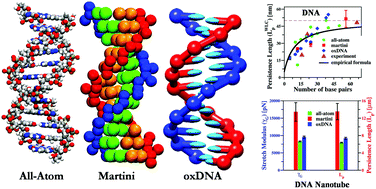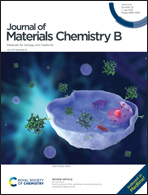Mechanical properties of DNA and DNA nanostructures: comparison of atomistic, Martini and oxDNA models†
Abstract
The flexibility and stiffness of small DNA molecules play a fundamental role ranging from several biophysical processes to nano-technological applications. Here, we estimate the mechanical properties of short double-stranded DNA (dsDNA) with lengths ranging from 12 base-pairs (bp) to 56 bp, paranemic crossover (PX) DNA and hexagonal DNA nanotubes (DNTs) using two widely used coarse-grained models – Martini and oxDNA. To calculate the persistence length (Lp) and the stretch modulus (γ) of the dsDNA, we incorporate the worm-like chain and elastic rod model, while for the DNTs, we implement our previously developed theoretical framework. We compare and contrast all of the results with previously reported all-atom molecular dynamics (MD) simulations and experimental results. The mechanical properties of dsDNA (Lp ∼ 50 nm, γ ∼ 800–1500 pN), PX DNA (γ ∼ 1600–2000 pN) and DNTs (Lp ∼ 1–10 μm, γ ∼ 6000–8000 pN) estimated using the Martini soft elastic network and oxDNA are in very good agreement with the all-atom MD and experimental values, while the stiff elastic network Martini reproduces values of Lp and γ which are an order of magnitude higher. The high flexibility of small dsDNA is also depicted in our calculations. However, Martini models proved inadequate to capture the salt concentration effects on the mechanical properties with increasing salt molarity. oxDNA captures the salt concentration effect on the small dsDNA mechanics. But it is found to be ineffective for reproducing the salt-dependent mechanical properties of DNTs. Also, unlike Martini, the time evolved PX DNA and DNT structures from the oxDNA models are comparable to the all-atom MD simulated structures. Our findings provide a route to study the mechanical properties of DNA and DNA based nanostructures with increased time and length scales and has a remarkable implication in the context of DNA nanotechnology.

- This article is part of the themed collection: Showcasing recent research in materials chemistry from IIT Bombay, IIT Indore and IISc


 Please wait while we load your content...
Please wait while we load your content...